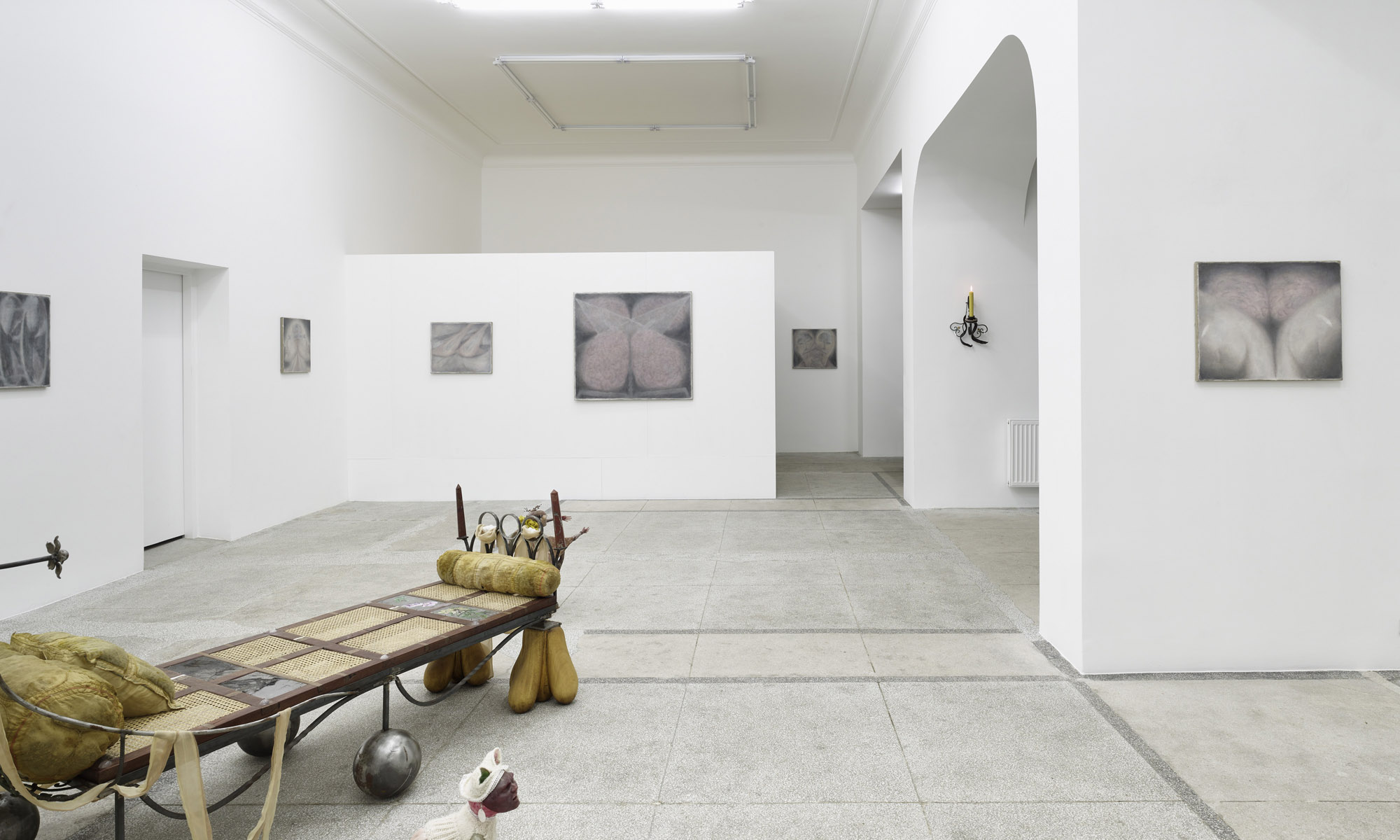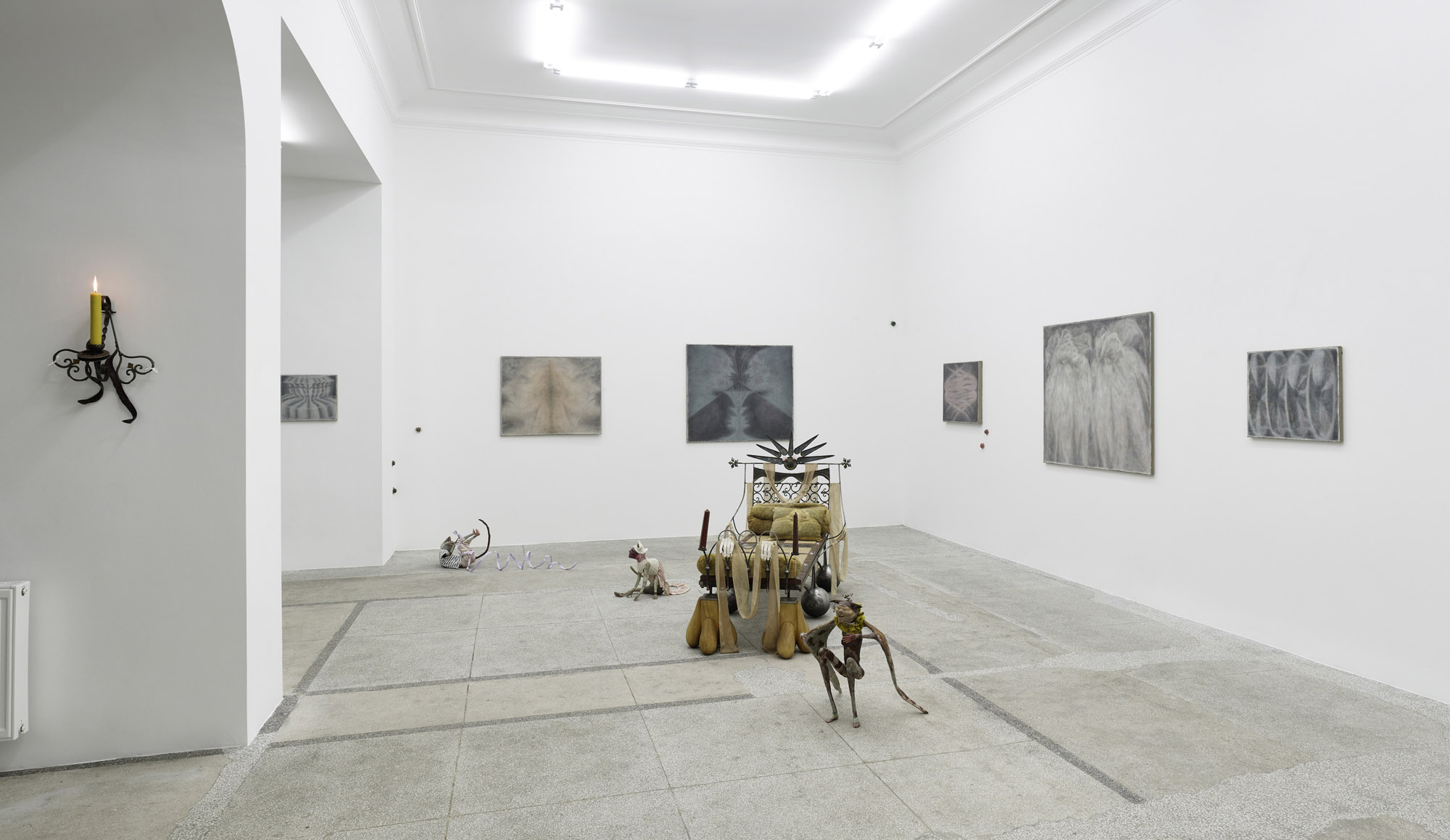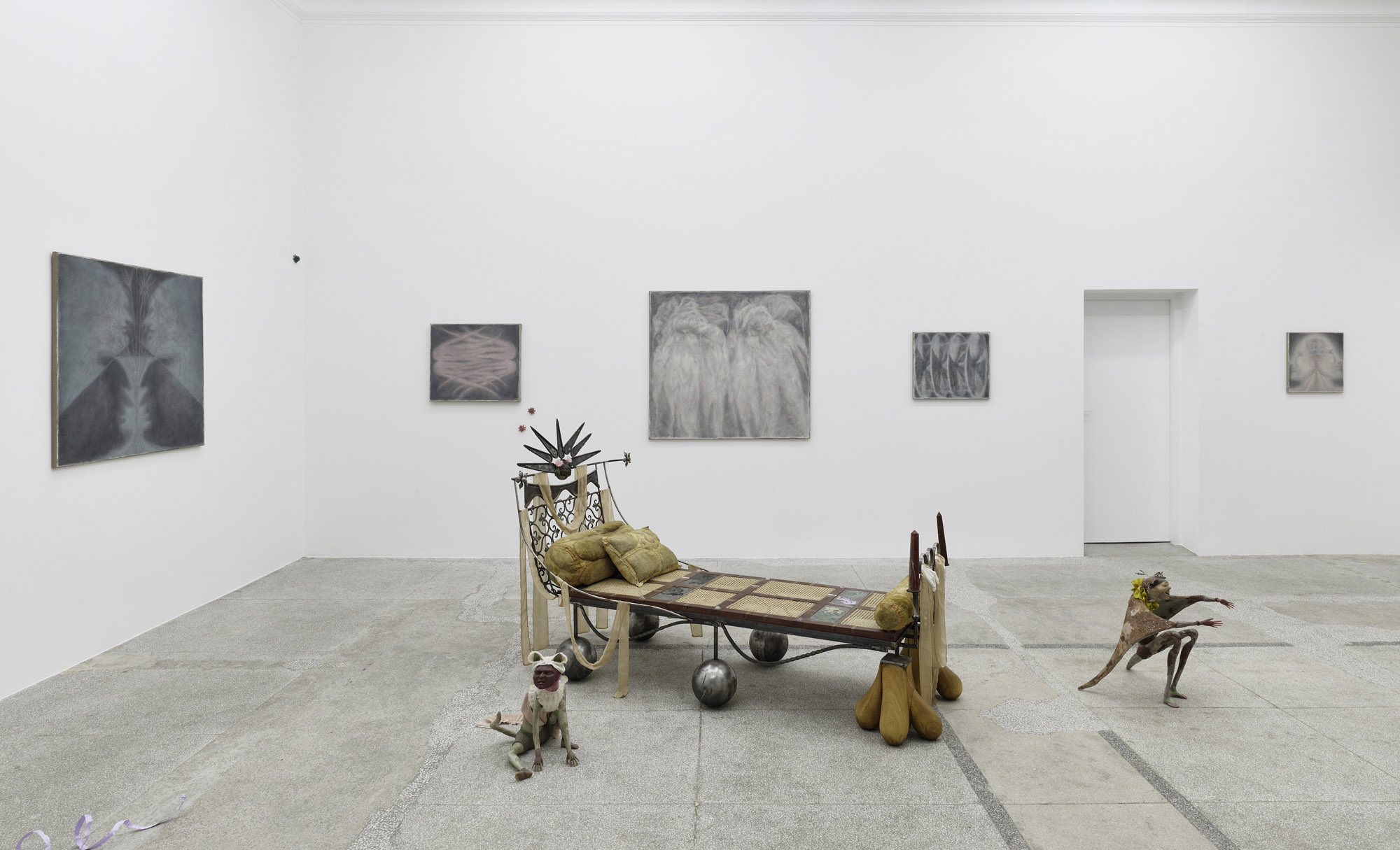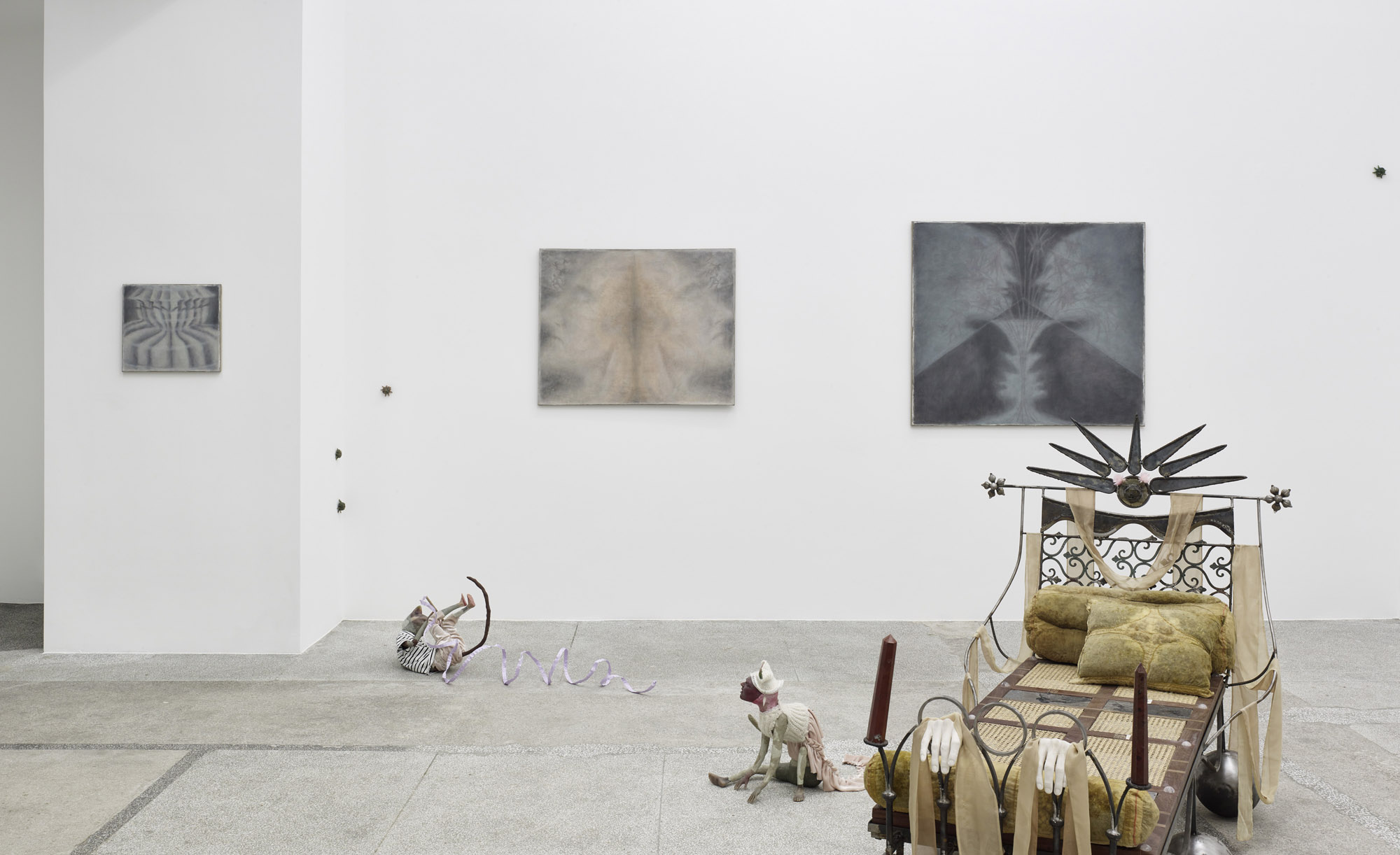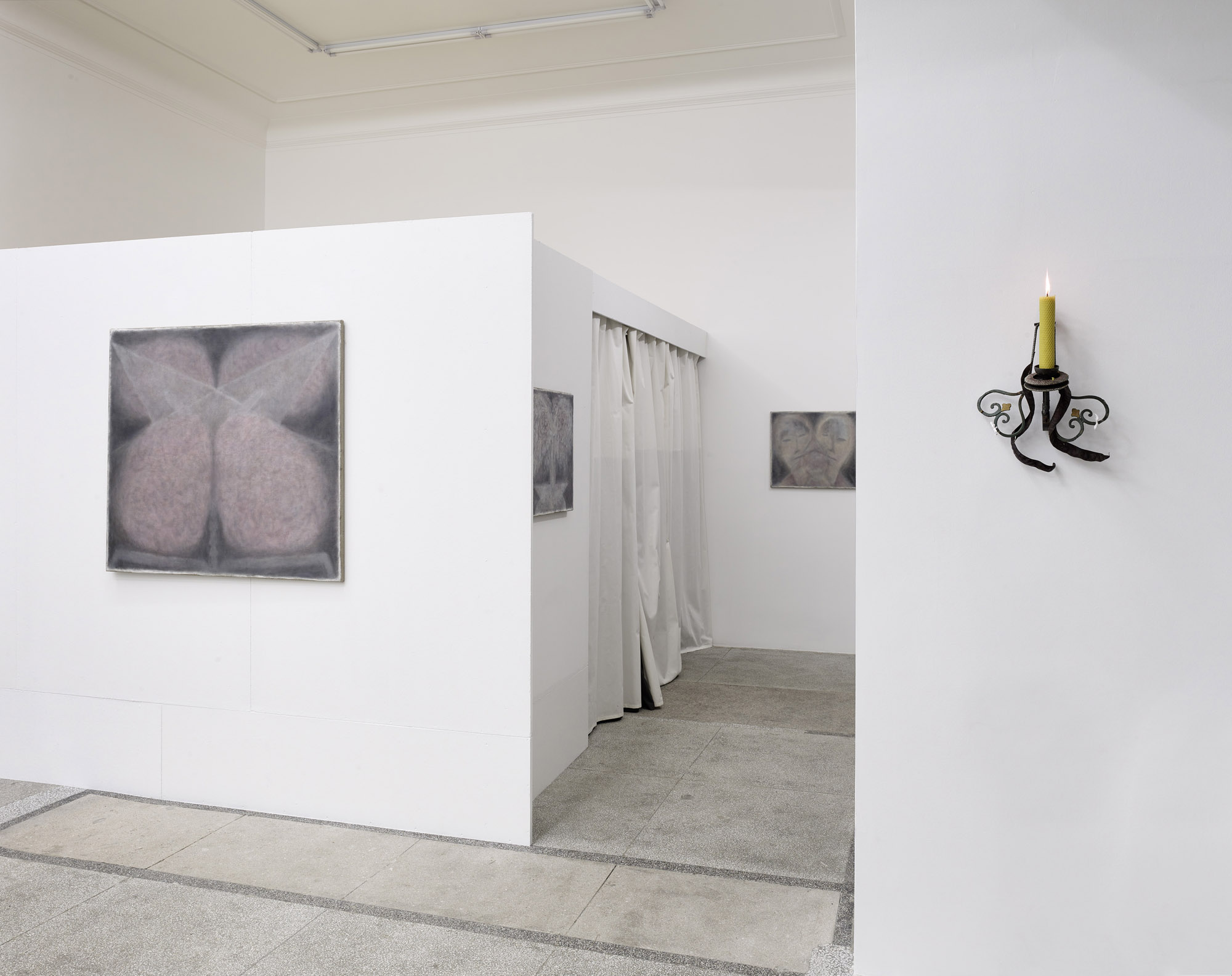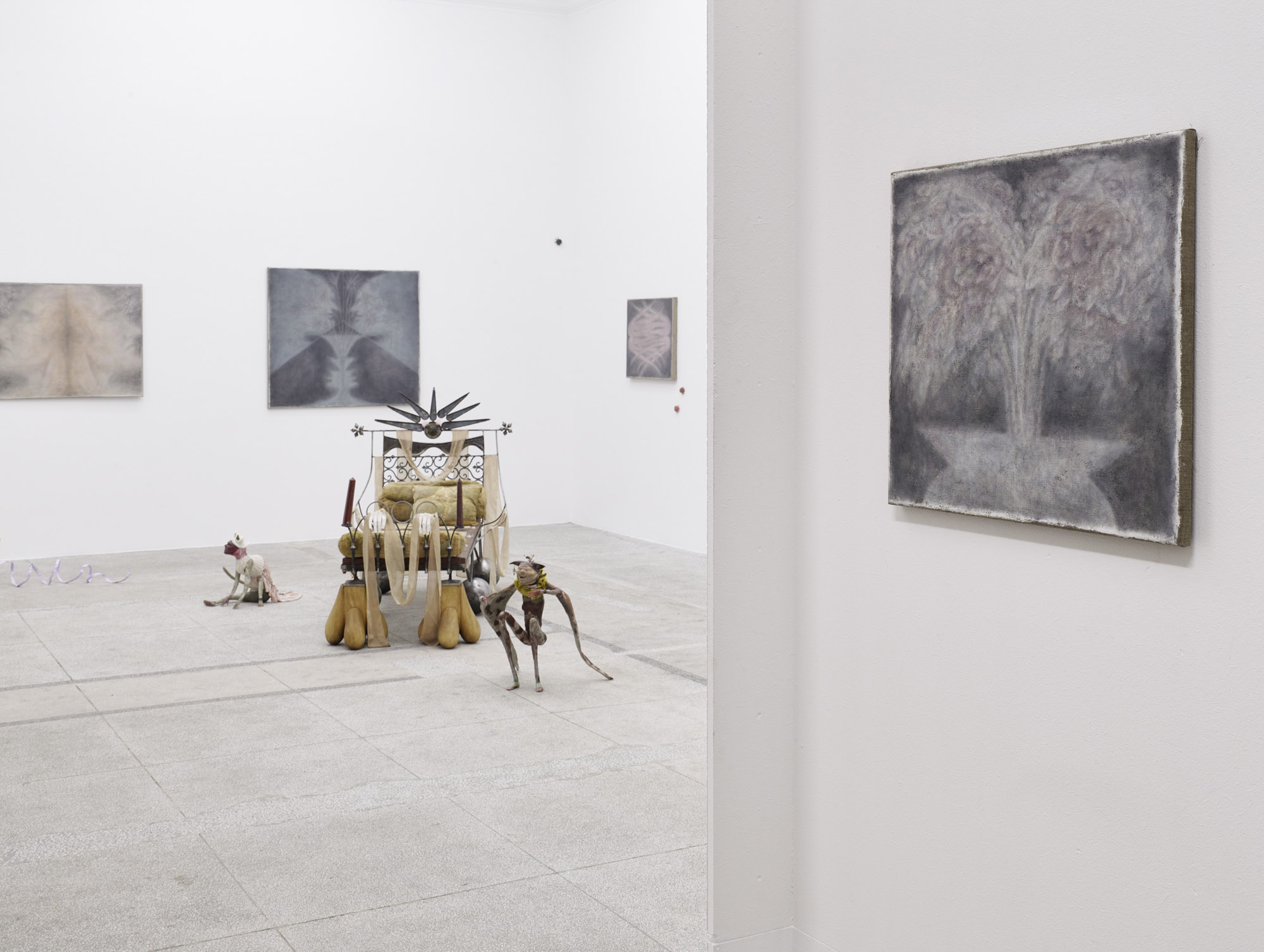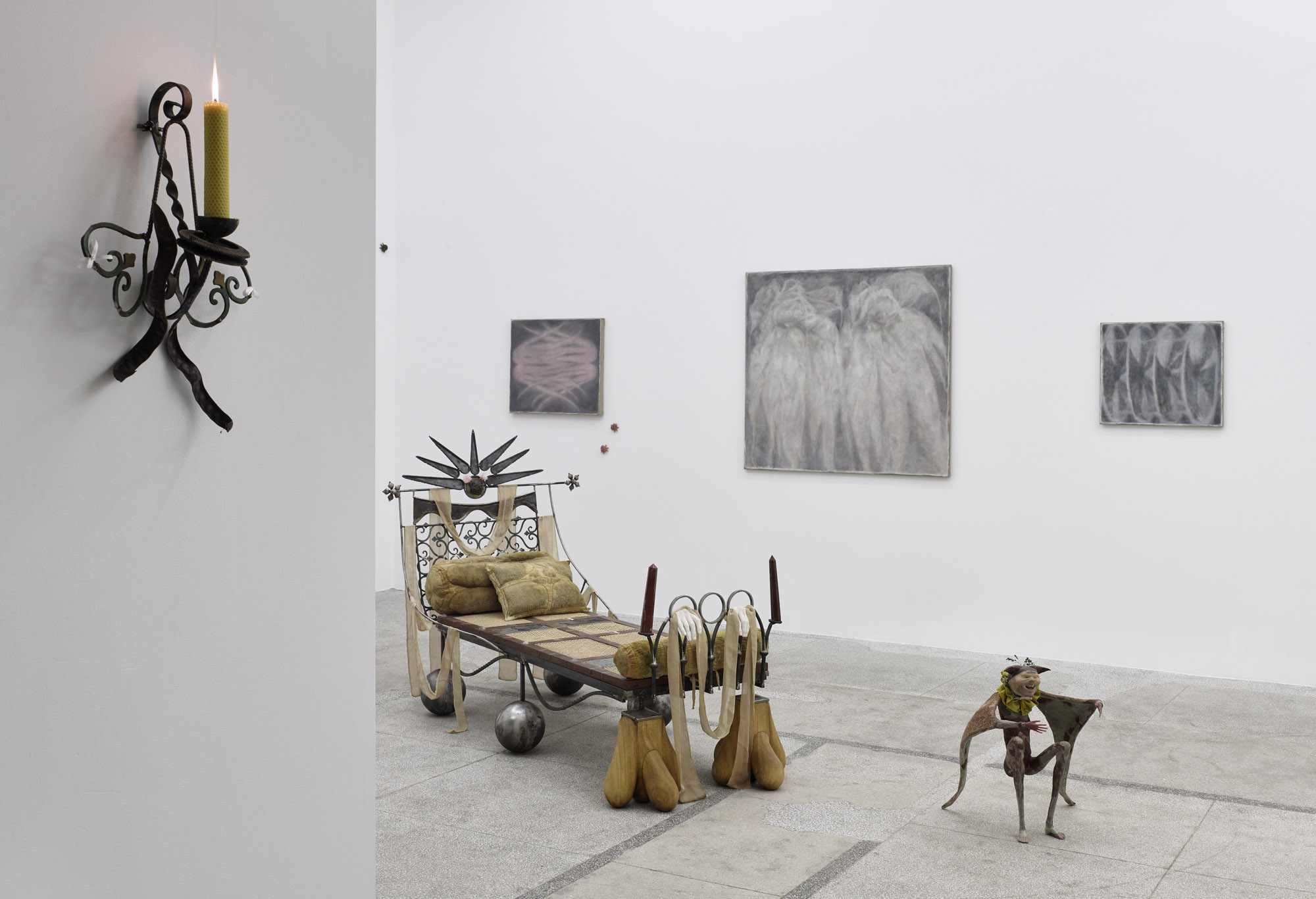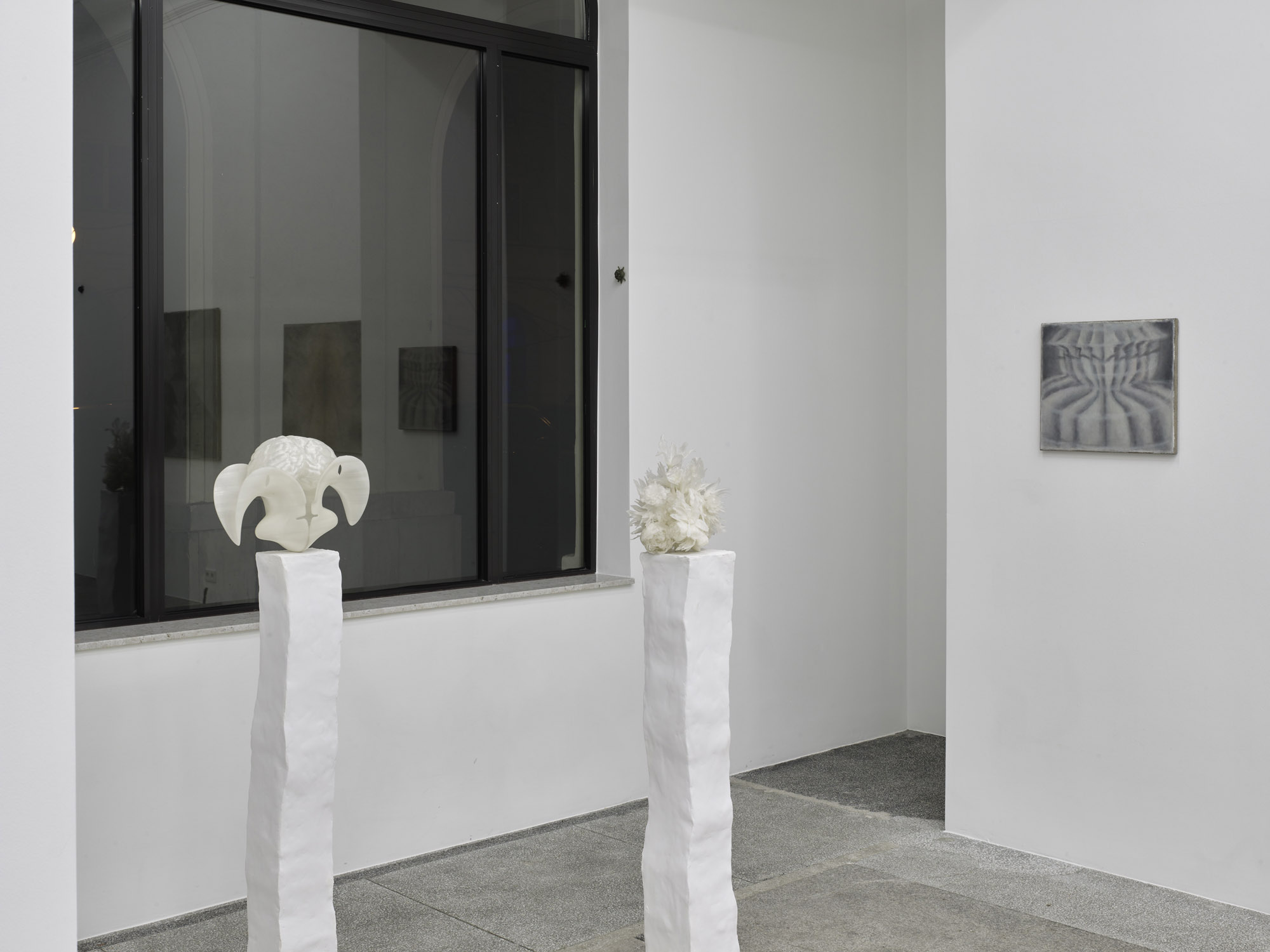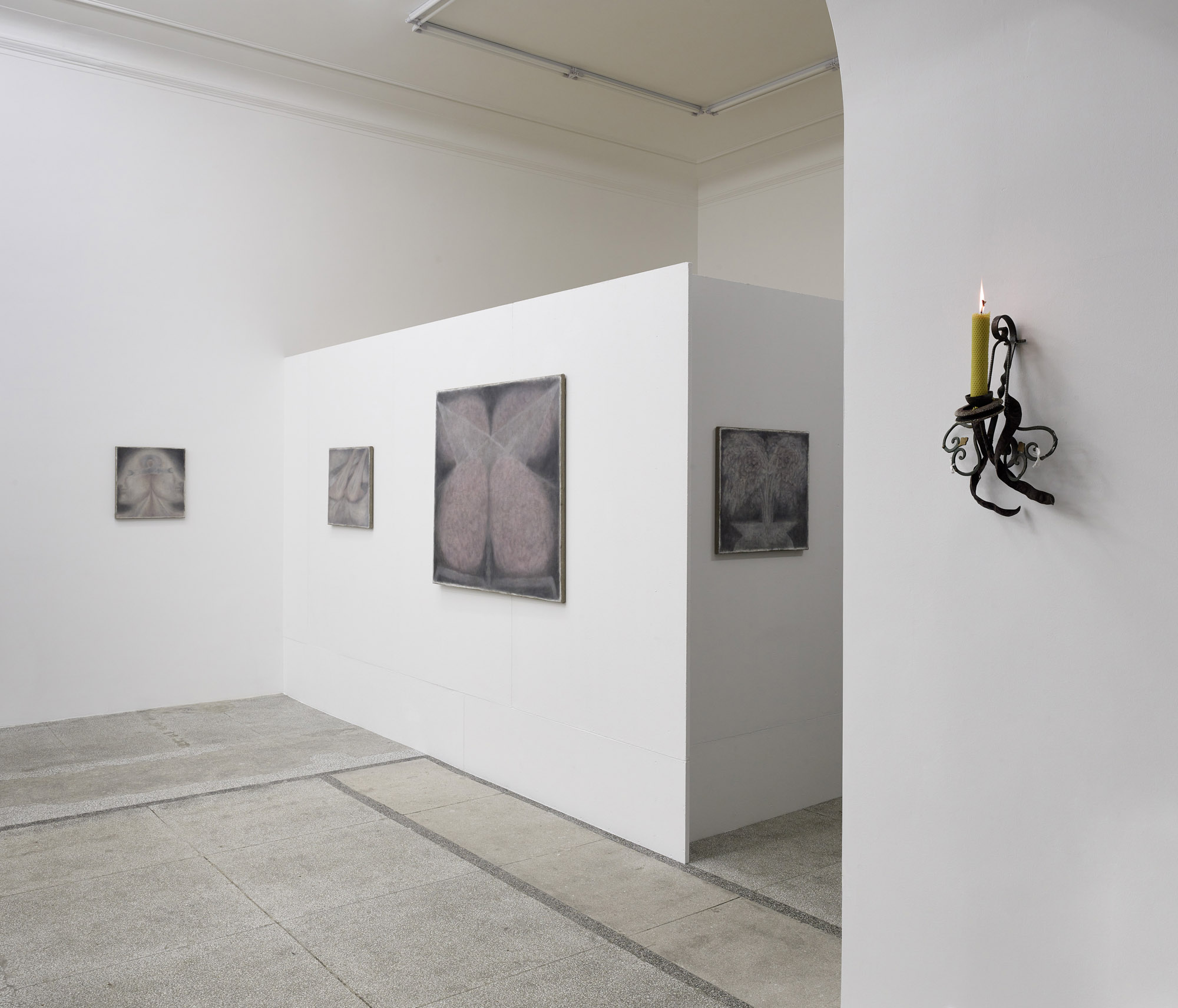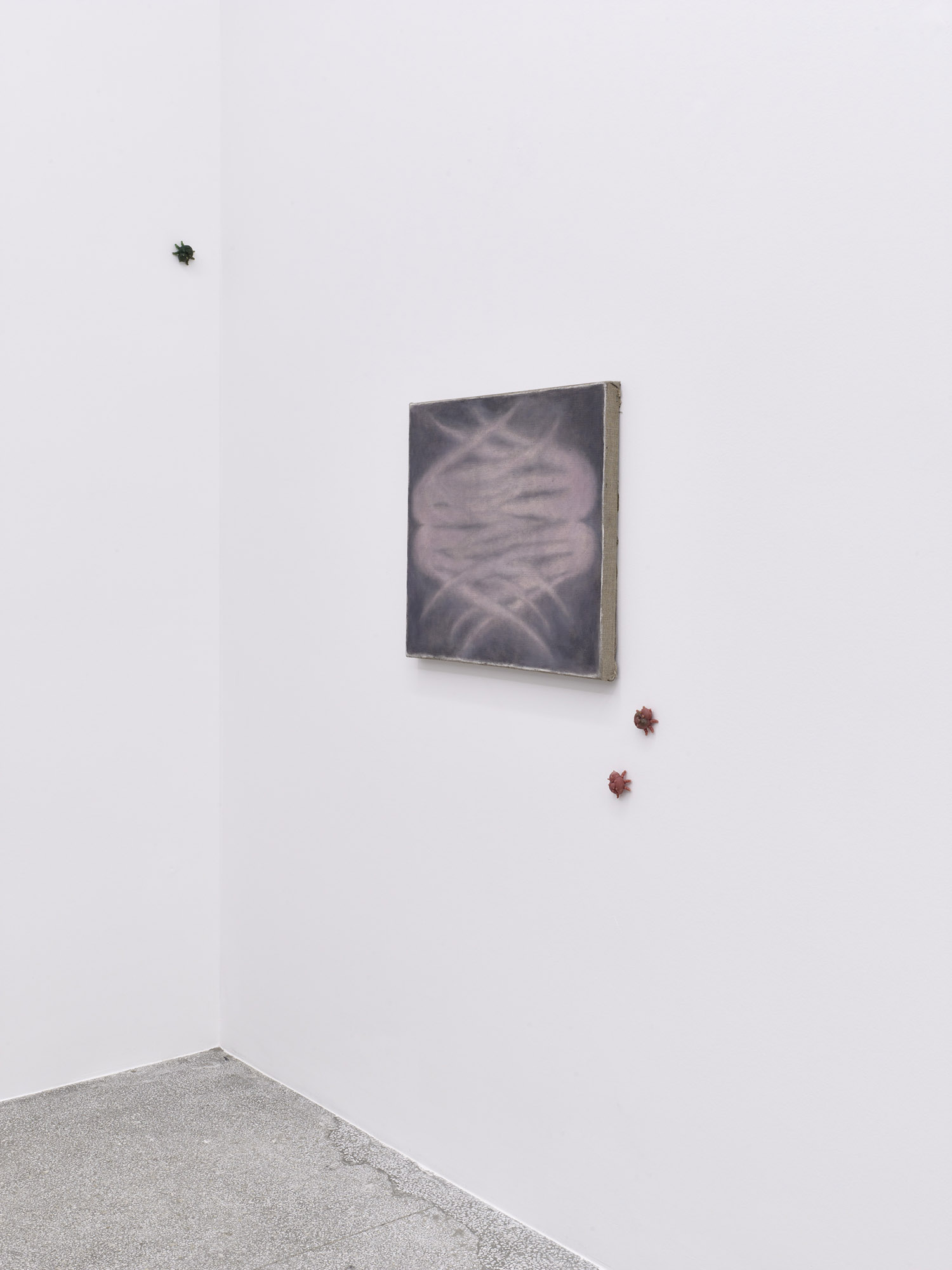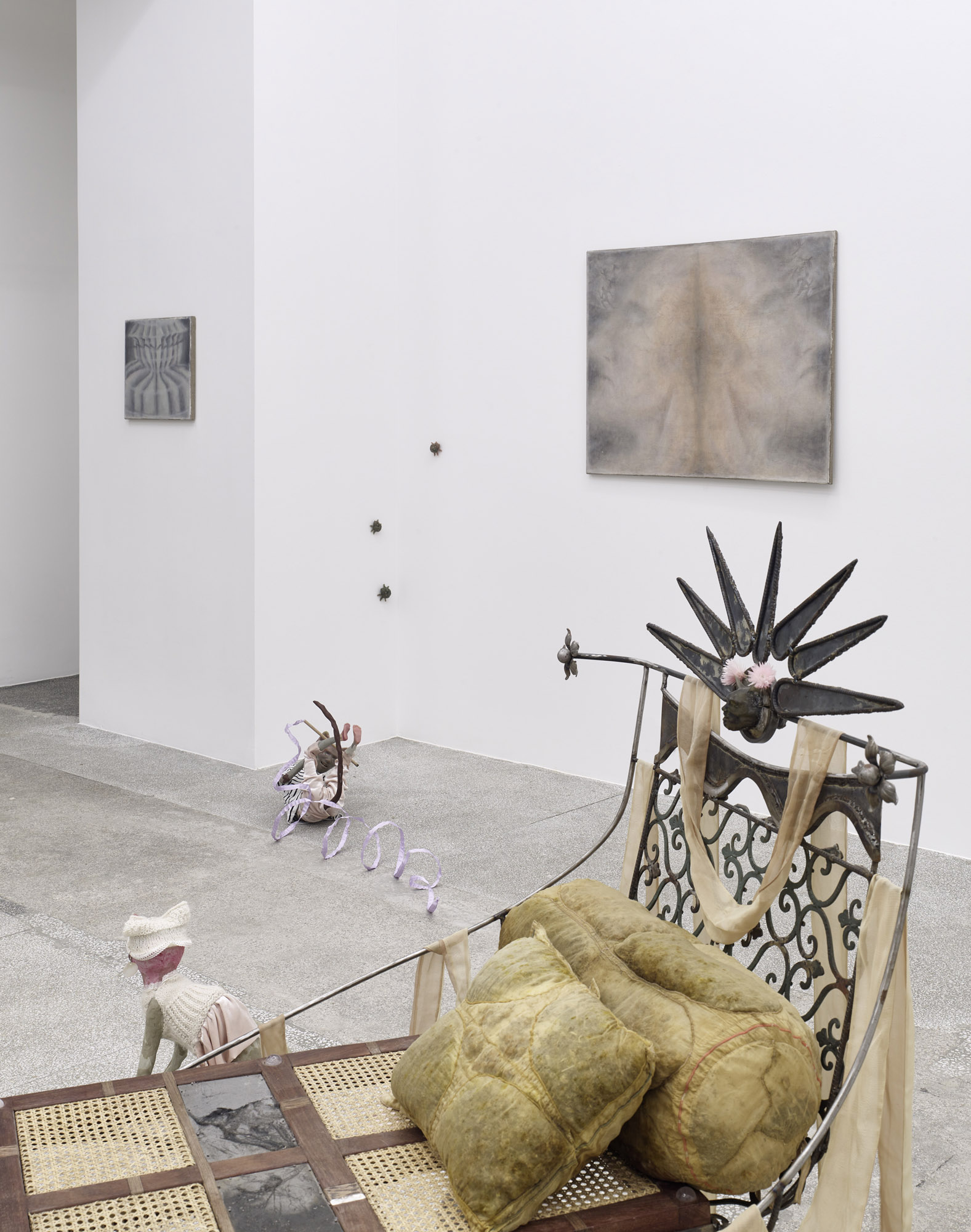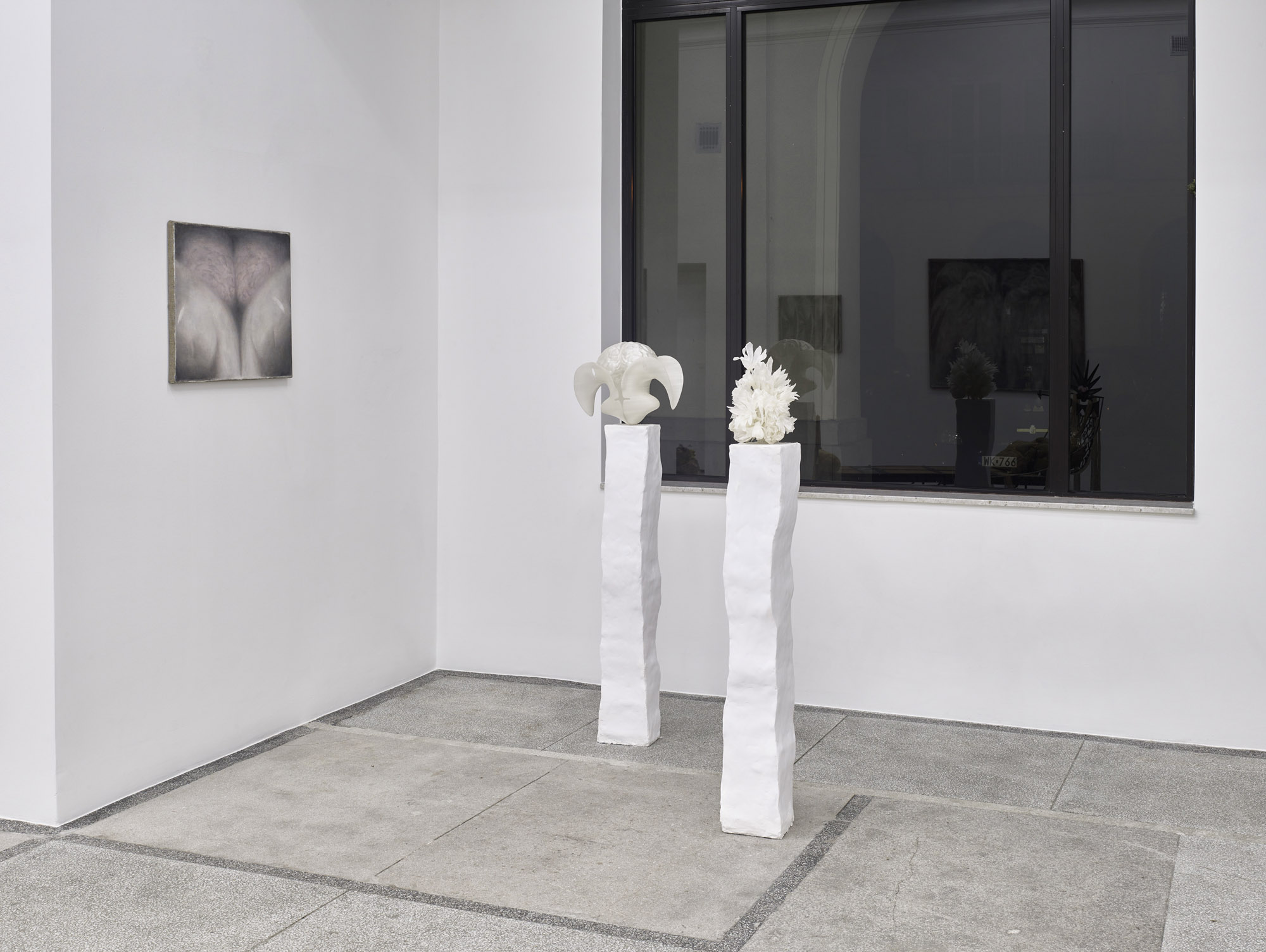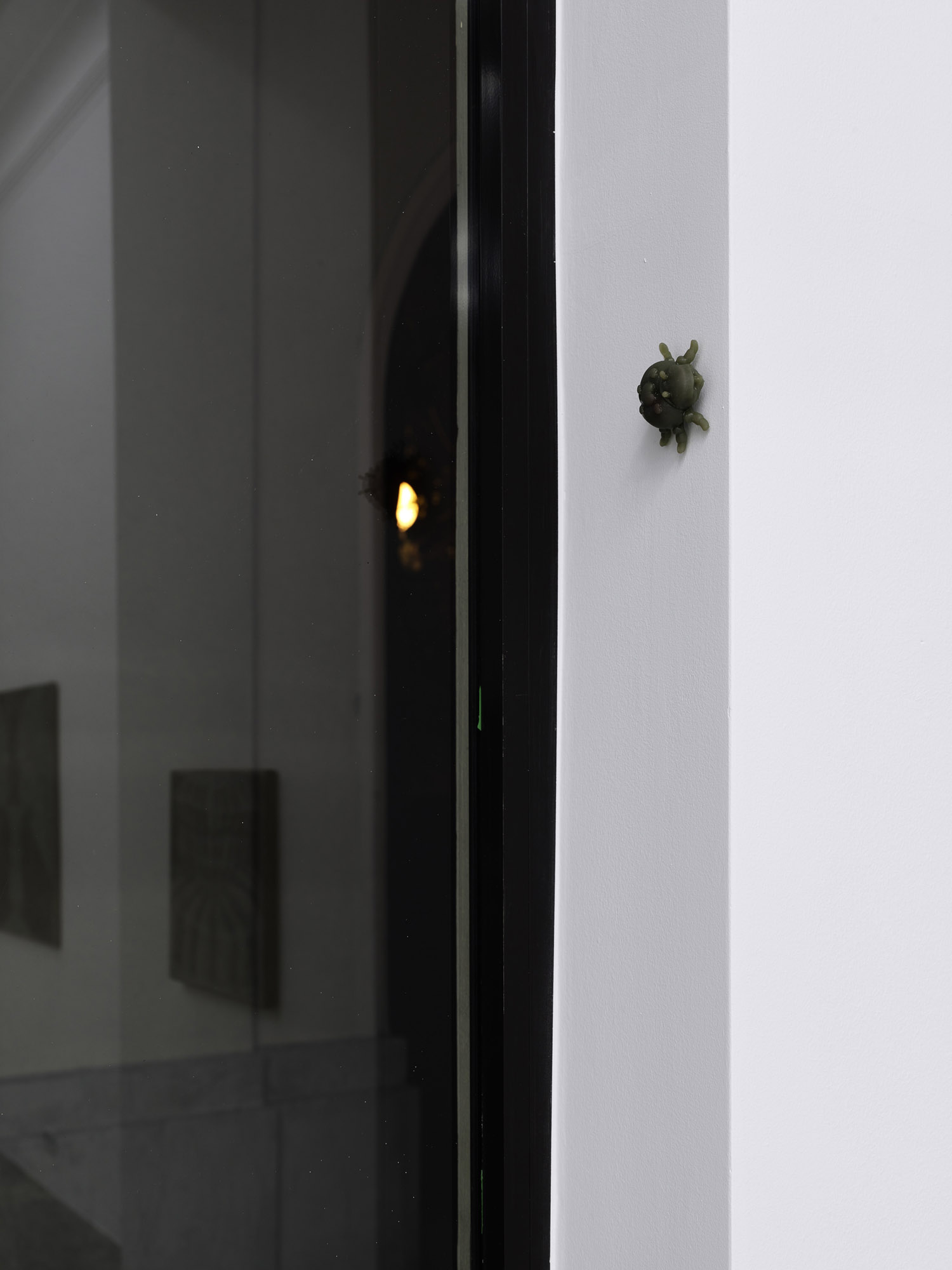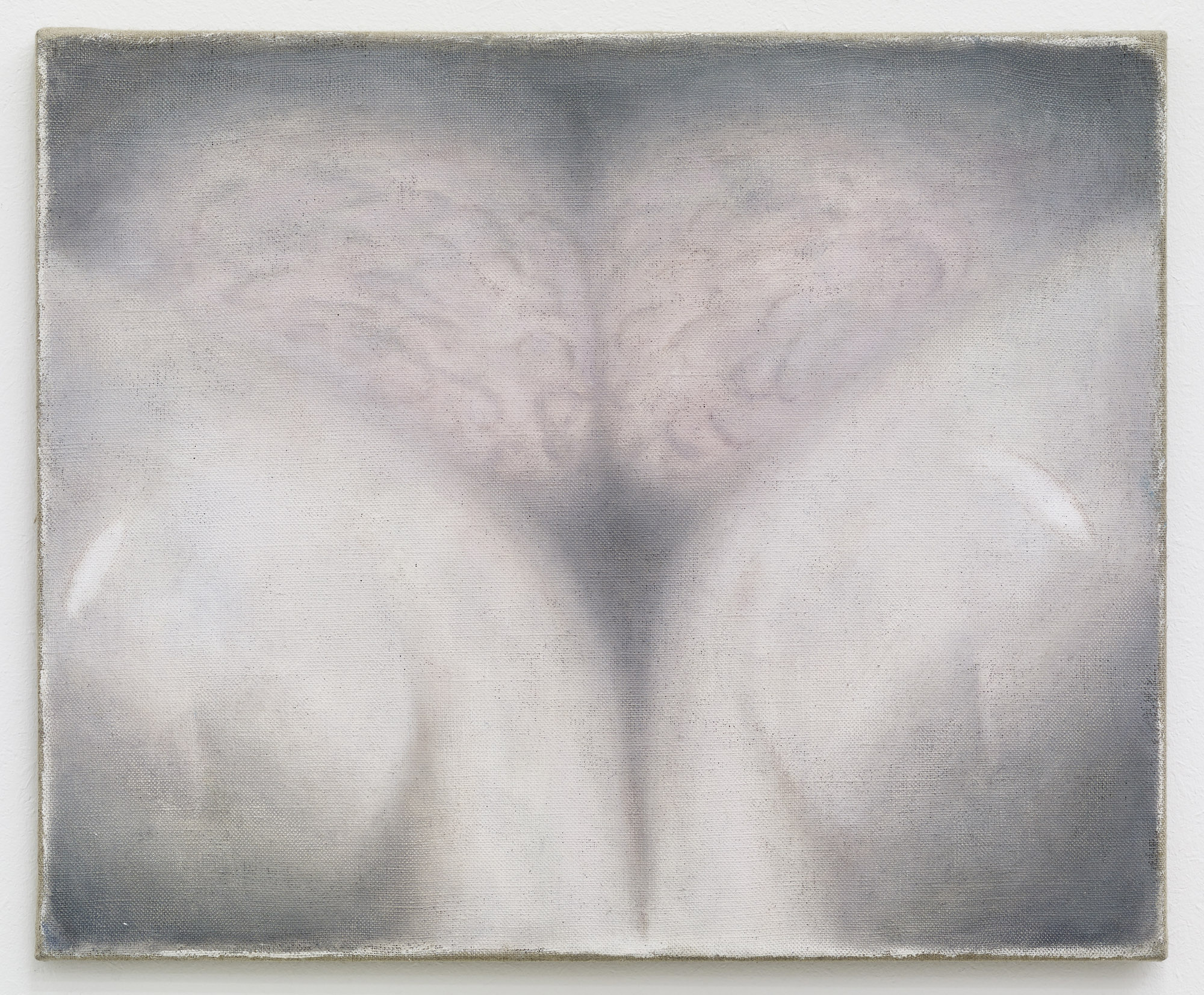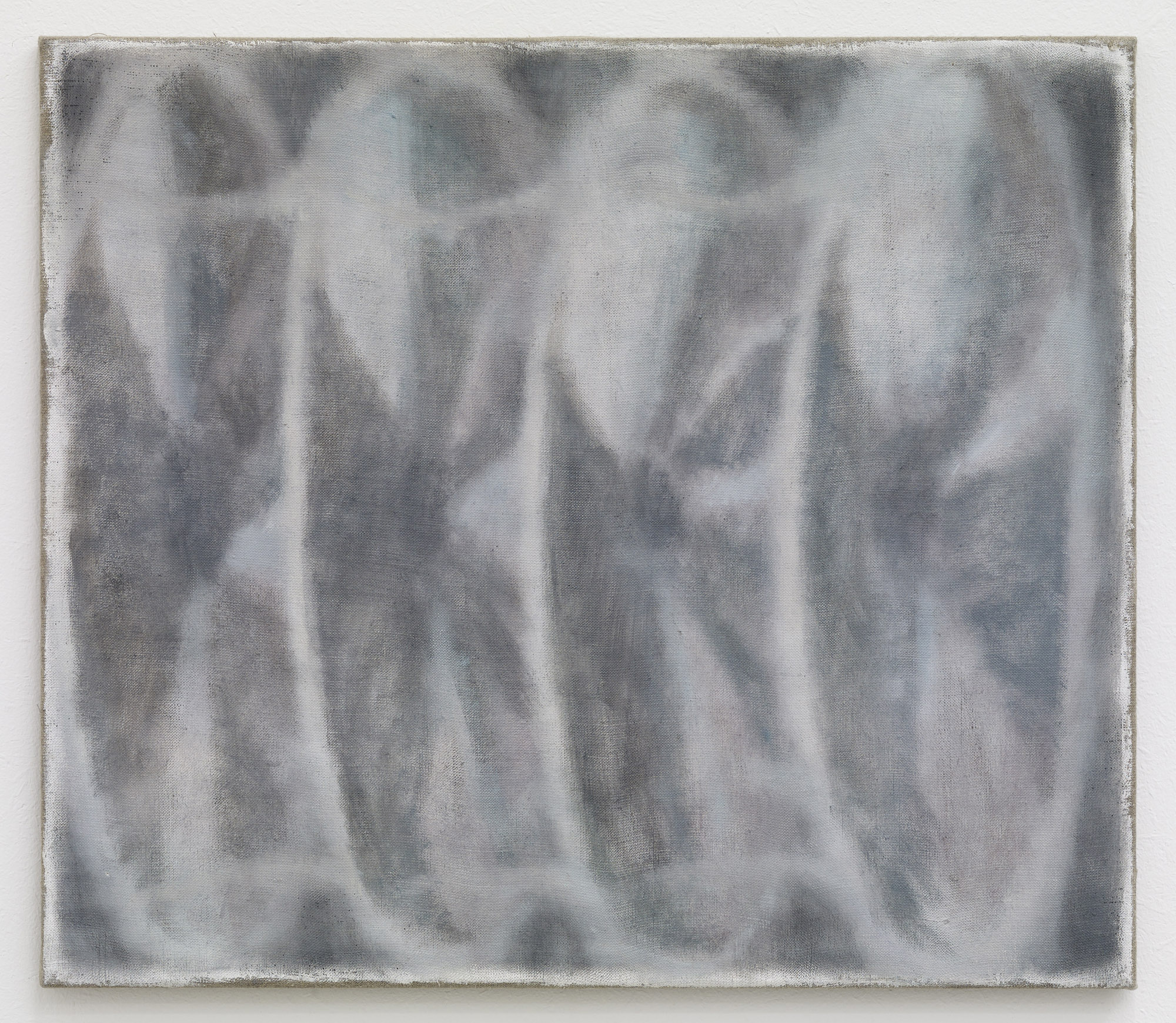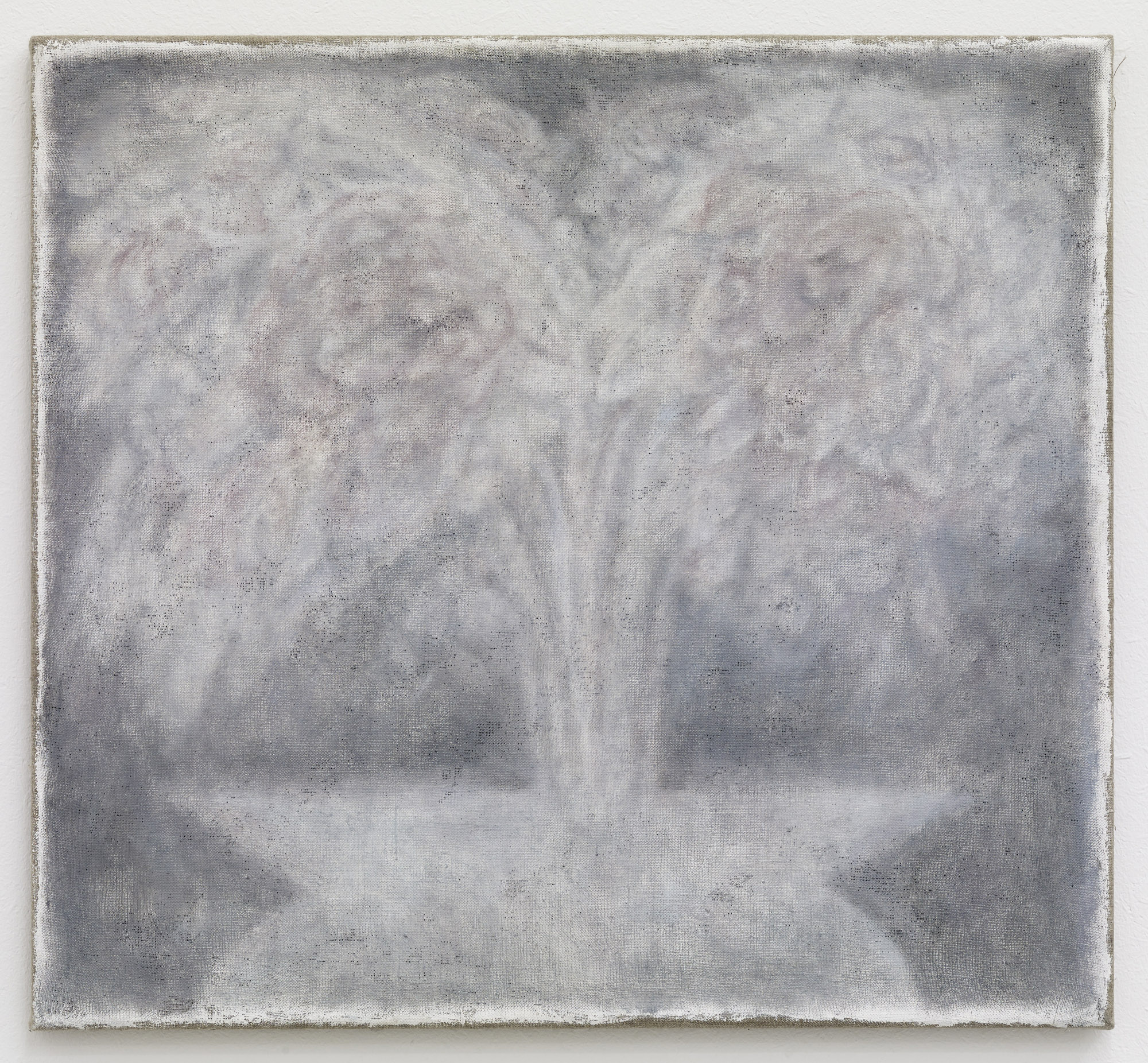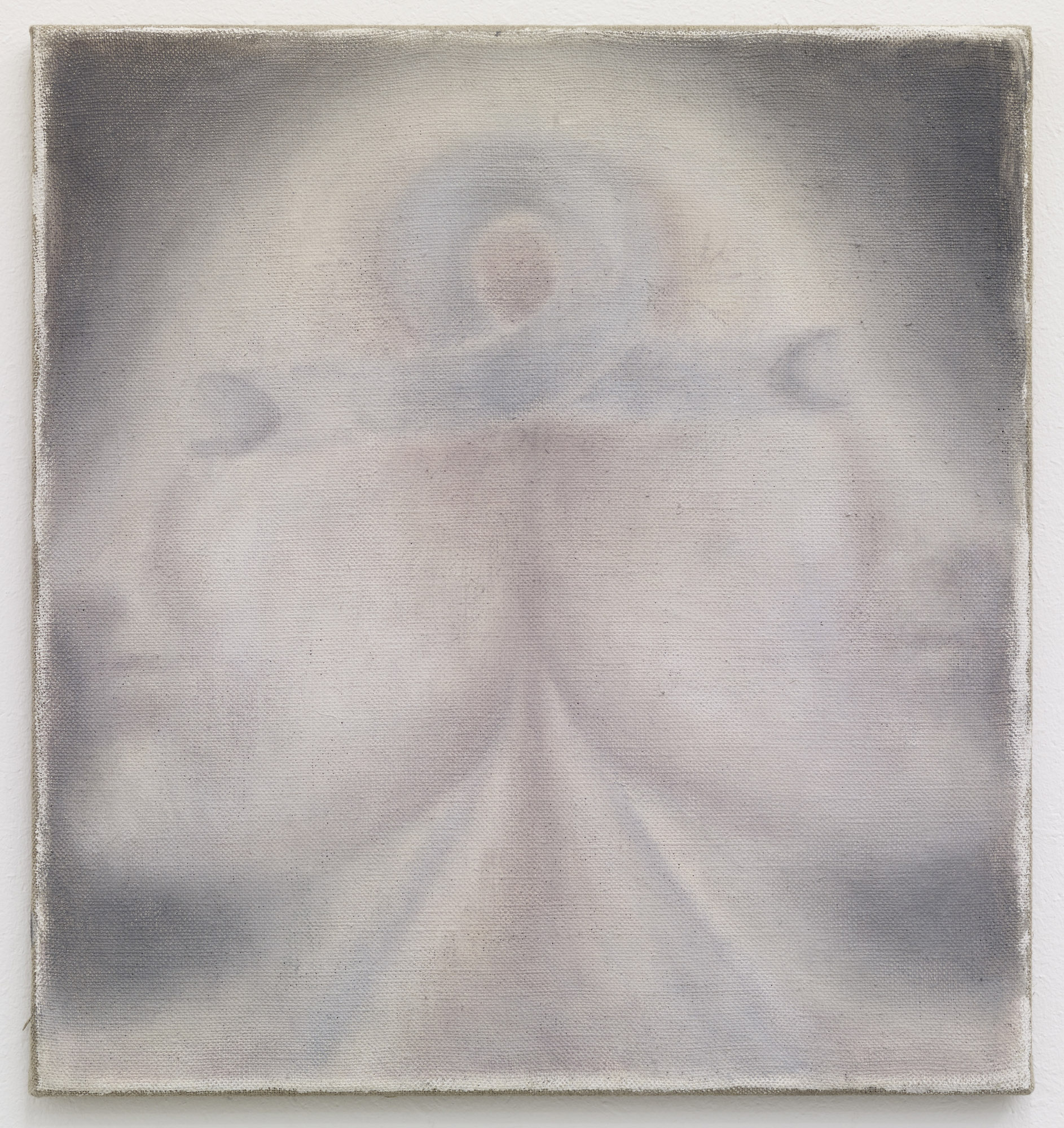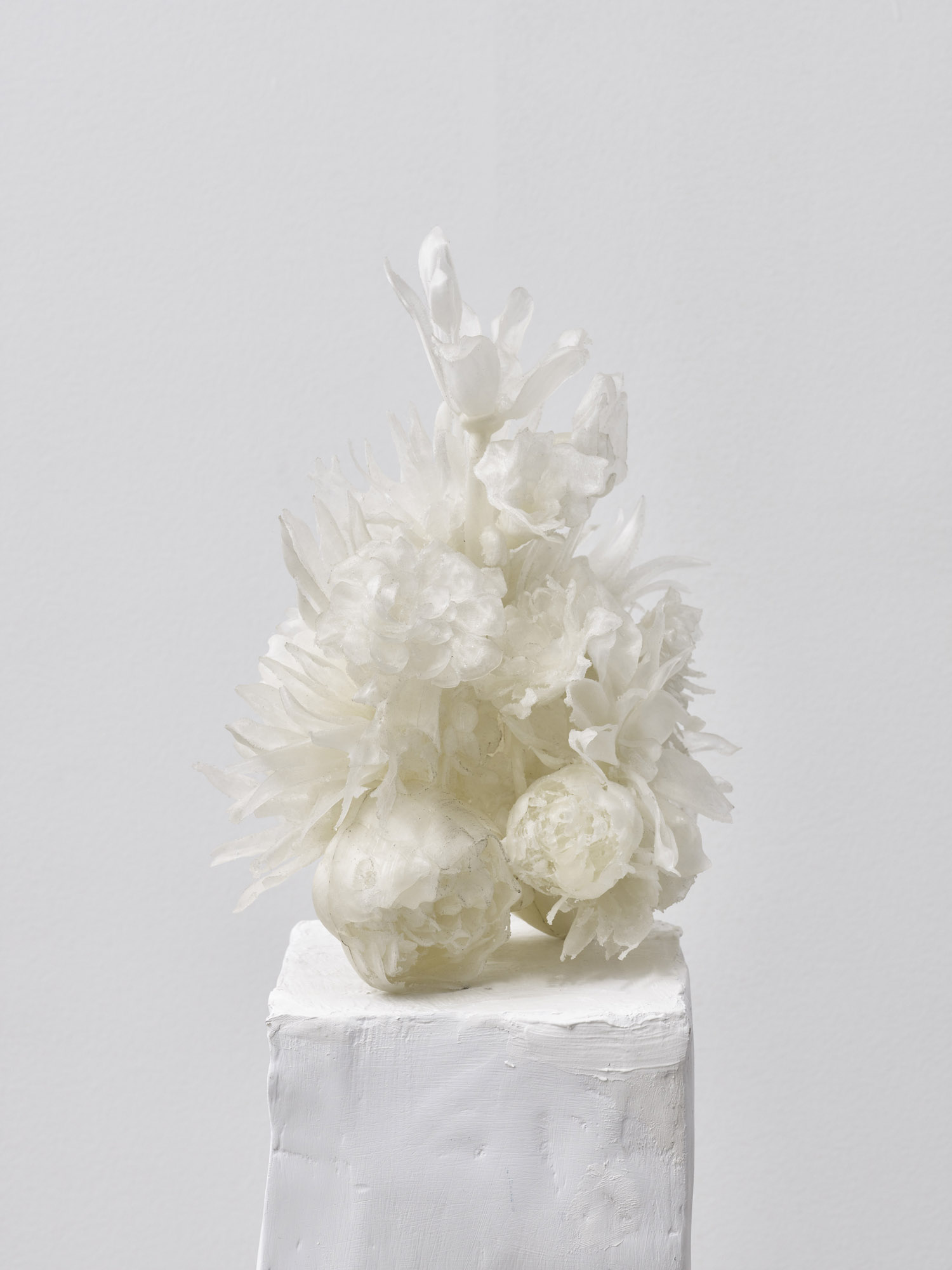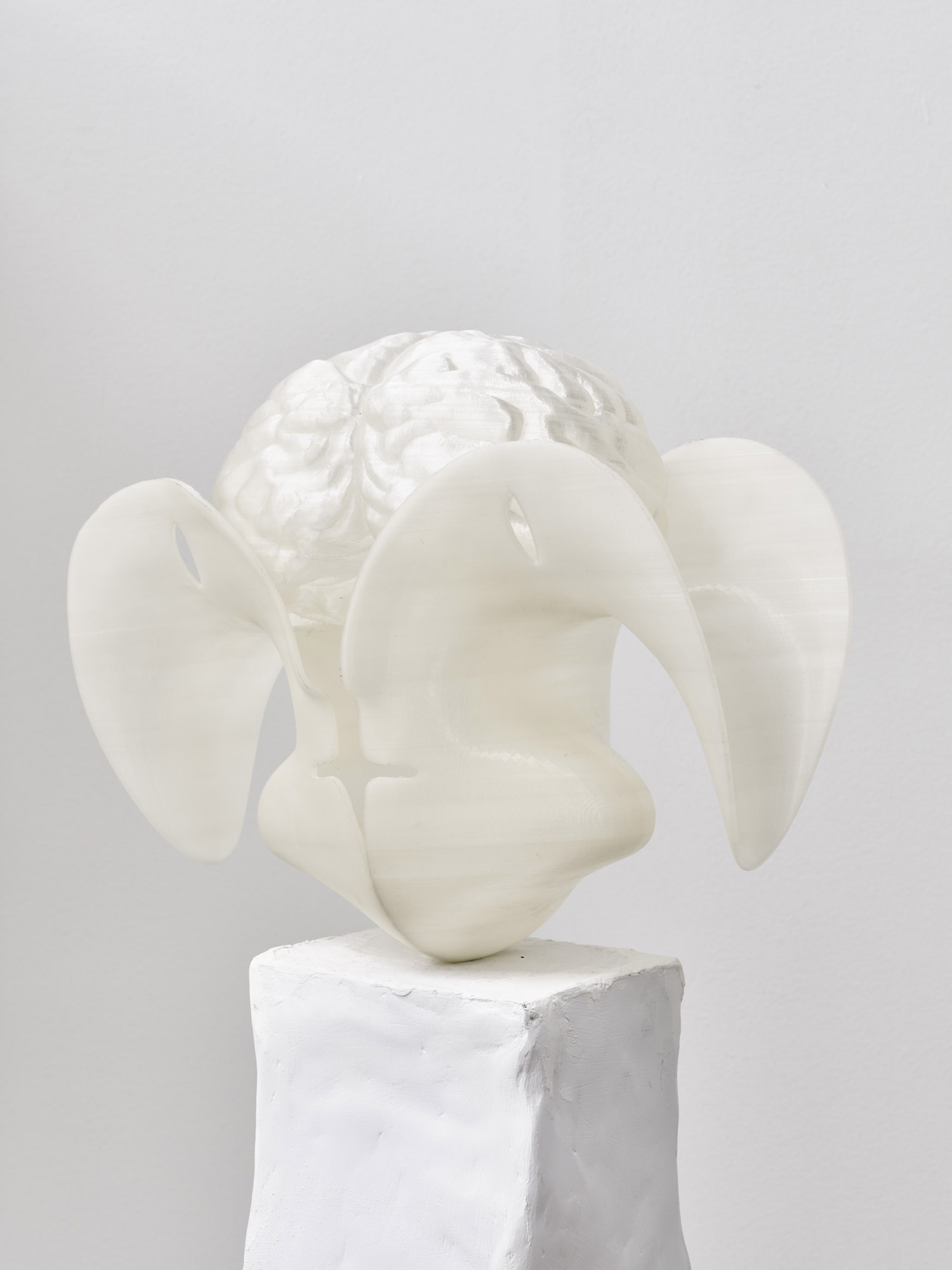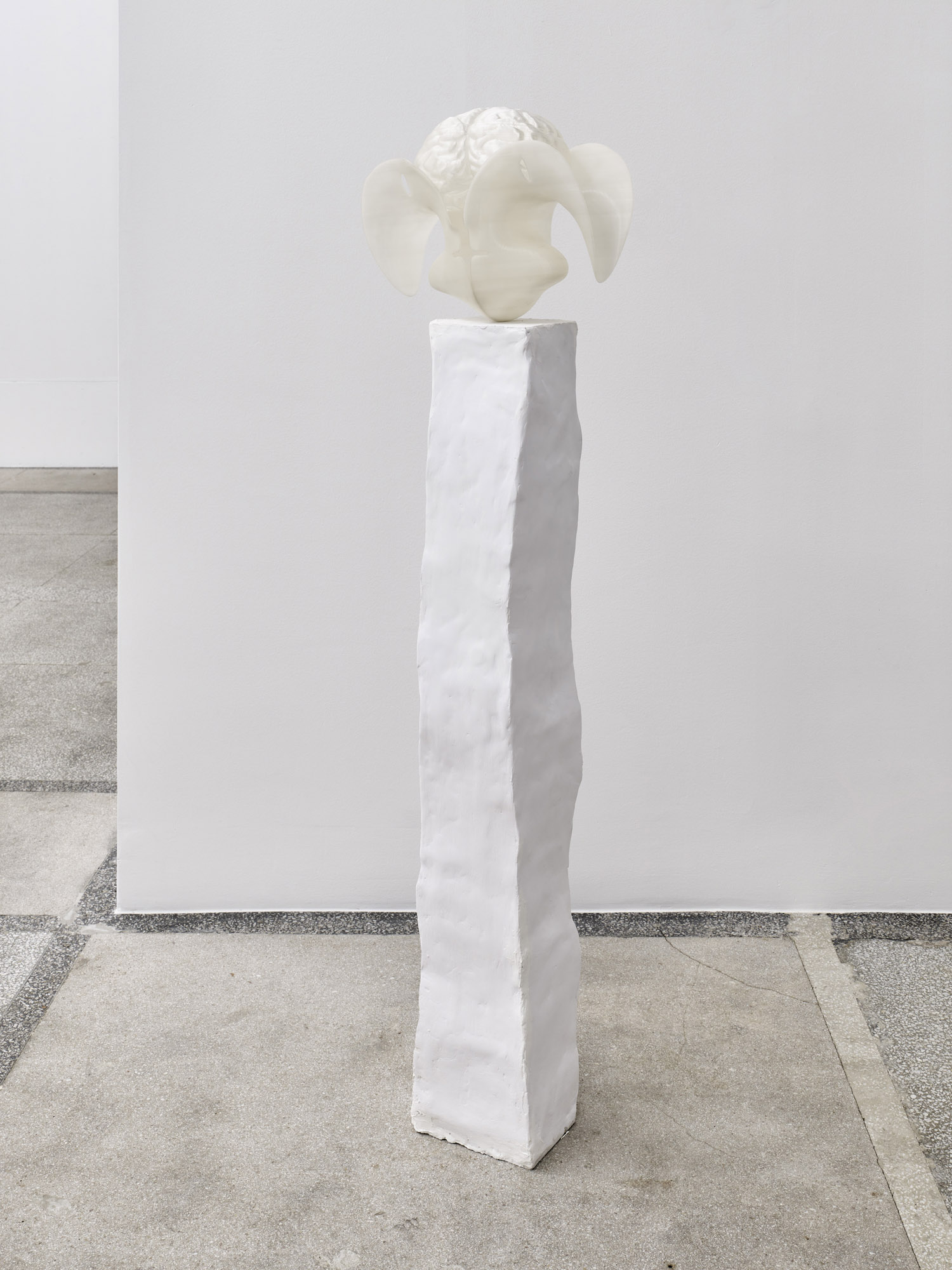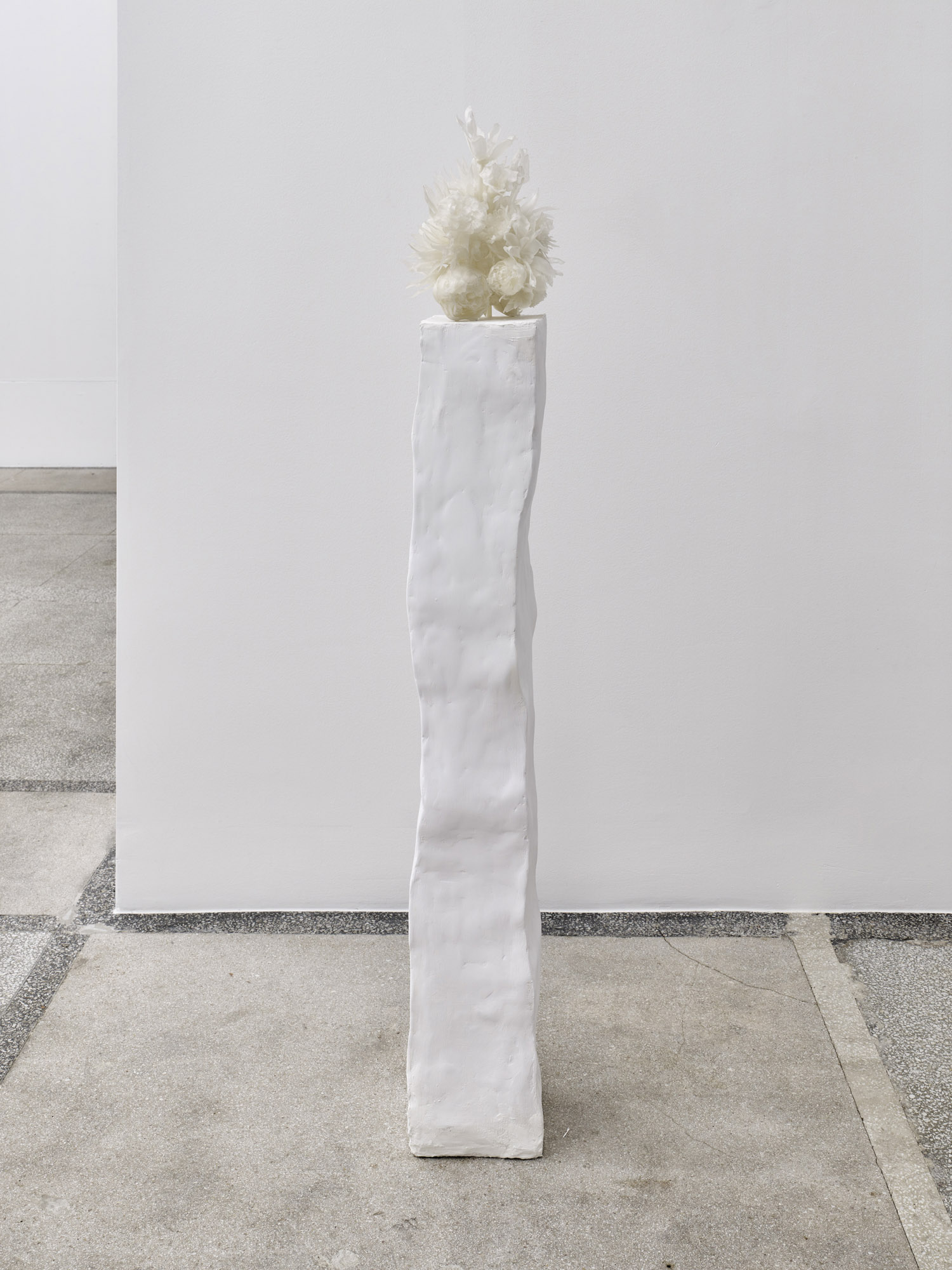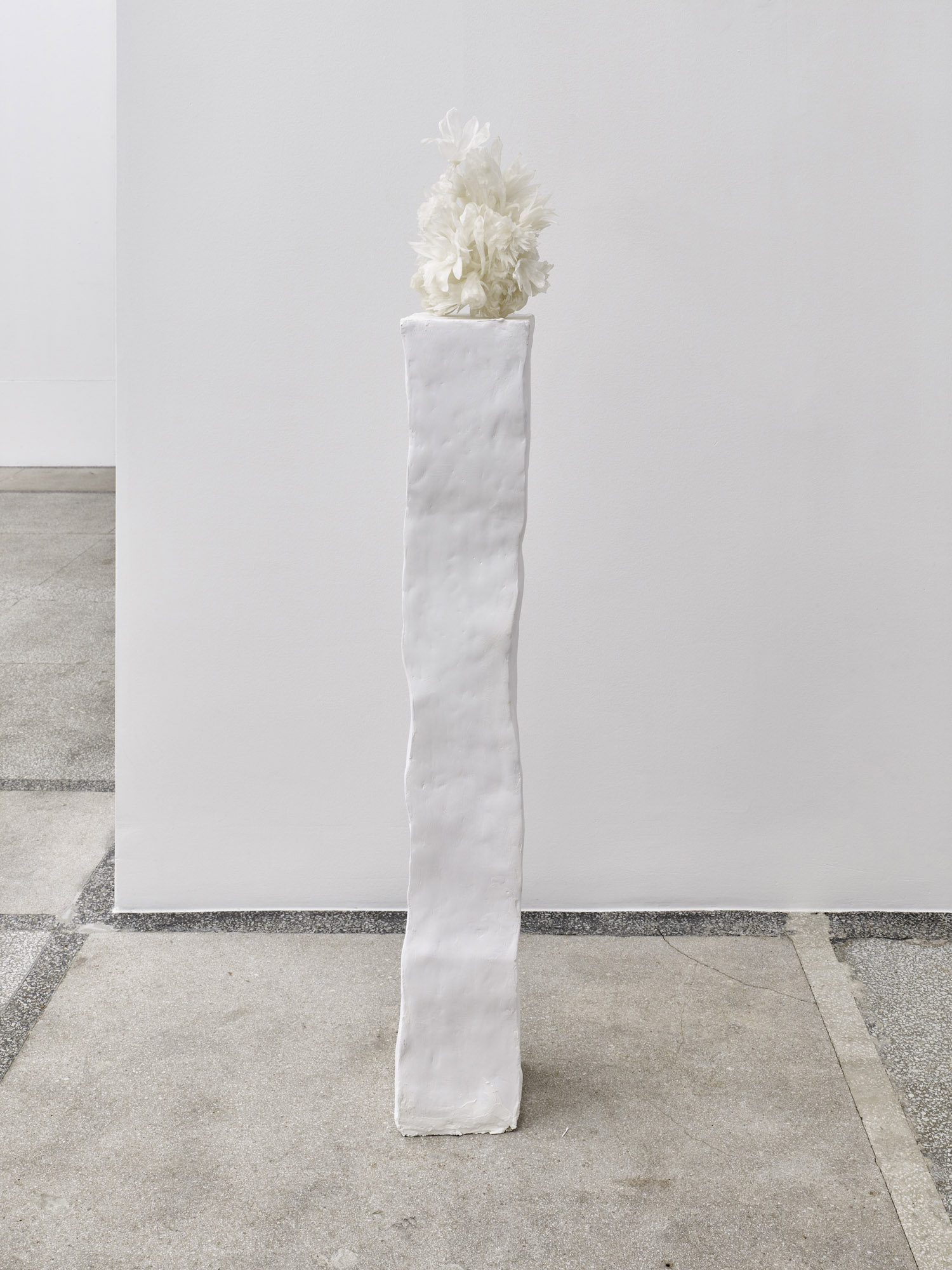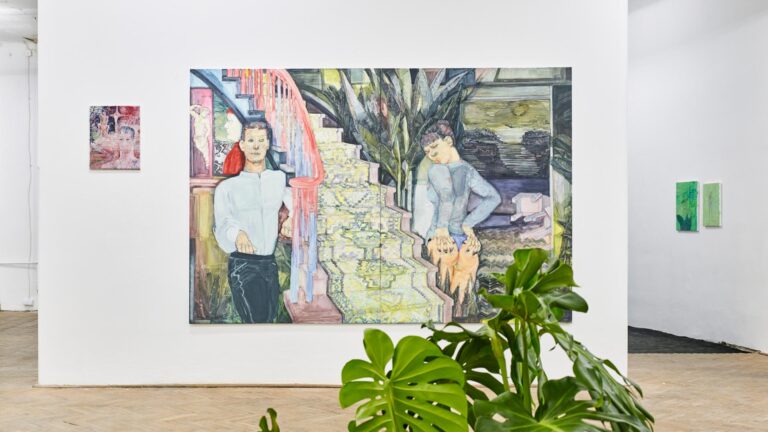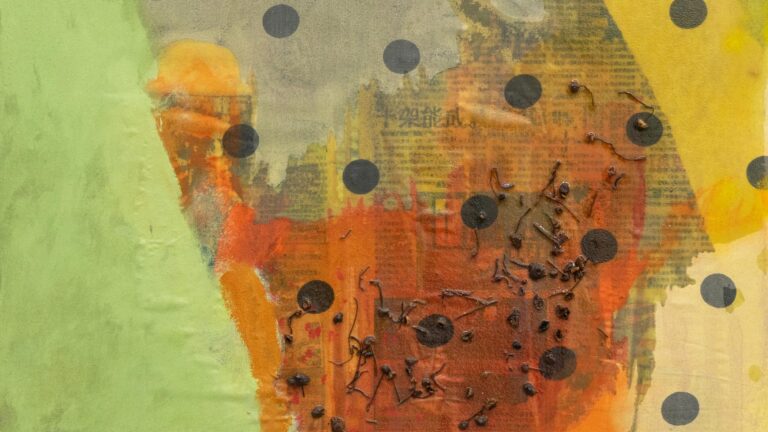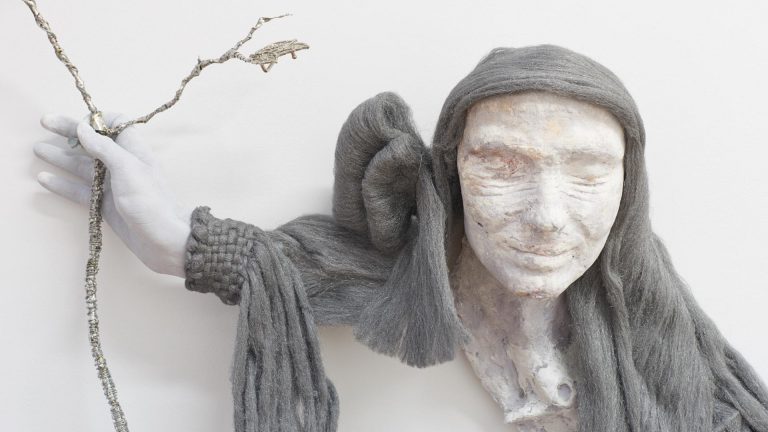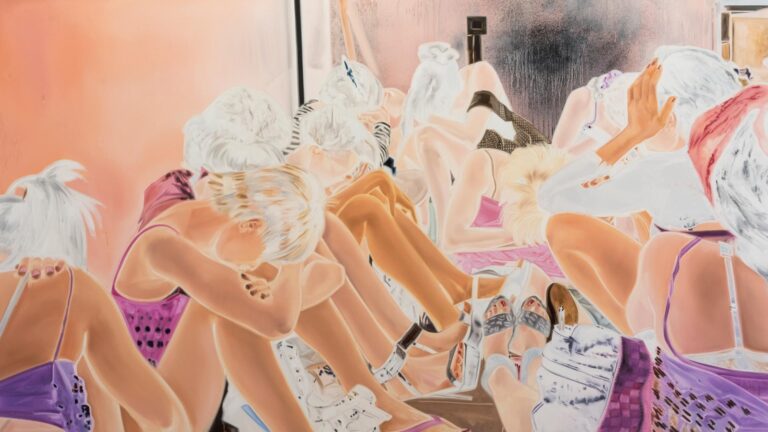Artists: Nils Alix-Tabeling and Paweł Olszewski
Exhibition title: Split #2
Venue: Piktogram, Warsaw, Poland
Date: November 10 – December 23, 2022
Photography: all images copyright and courtesy of the artists and Piktogram, Warsaw
We are pleased to invite you to an exhibition of works by two artists – Nils Alix-Tabeling and Paweł Olszewski.
Instead of describing the works that can be seen at the exhibition, let us briefly introduce just two of many figures that inspired the artists working on them. They are Elagabalus (Nils Alix-Tabeling) and Terrence A. Davis (Paweł Olszewski).
*
Marcus Aurelius Antoninus (born Sextus Varius Avitus Bassianus, c. 204 – 11/12 March, 222), better known by his nickname “Elagabalus”, was Roman emperor from 218 to 222, while he was still a teenager. His short reign was conspicuous for sex scandals and religious controversy. A close relative to the Severan dynasty, he came from a prominent Arab family in Emesa (Homs), Syria, where since his early youth he served as head priest of the sun god Elagabal. After the death of his cousin, the emperor Caracalla (and there were rumors that he was Caracalla’s child), Elagabalus was raised to the principate at 14 years of age in an army revolt instigated by his grandmother Julia Maesa against Caracalla’s short-lived successor, Macrinus. He only posthumously became known by the Latinised name of the Arabic إِ ٰل ُه ا ْل َجبَ ِل Ilāh al-Jabal, from ilāh (“god”) and jabal (“mountain”), meaning “God of the Mountain”, the Emesene manifestation of Ba’al.
Cassius Dio writes that in order to increase his piety as high priest of Elagabal atop a new Roman pantheon, Elagabalus had himself circumcised and swore to abstain from swine. He used to force senators to watch while he danced circling the altar of Elagabal to the accompaniment of drums and cymbals. It was said that rituals to have involved priests conducting frenzied, ritualistic ceremonies where men castrated themselves while in a collective trance.
The question of Elagabalus’s sexual orientation is confused, owing to salacious and unreliable sources. He married four women, including a Vestal Virgin, as well as lavished favours on male courtiers thought to have been his lovers. Dio states that Elagabalus was married five times (twice to the same woman). And that another “husband of this woman [Elagabalus] was Hierocles”, an ex-slave and chariot driver from Caria. The Augustan History claims that Elagabalus also married a man named Zoticus, an athlete from Smyrna, while Dio says only that Zoticus was his cubicularius. Dio adds Elagabalus delighted in being called Hierocles’s mistress, wife, and queen. And that Elagabalus prostituted himself in taverns and brothels. The emperor reportedly wore makeup and wigs, preferred to be called a lady and not a lord, and supposedly offered vast sums to any physician who could provide him with a vagina. For this reason, the emperor is seen by some writers as an early transgender figure and one of the first on record as seeking gender correction surgery.
His behavior estranged the Praetorian Guard, the Senate and the common people alike. Amidst growing opposition, at just 18 years of age he was assassinated and replaced by his cousin Severus Alexander in March 222. The assassination plot against Elagabalus was devised by Julia Maesa and carried out by disaffected members of the Praetorian Guard.
Elagabalus developed a reputation among his contemporaries for extreme eccentricity, decadence, zealotry and sexual promiscuity. This tradition has persisted; among writers of the early modern age he suffered one of the worst reputations among Roman emperors. Despite near-universal condemnation of his reign, some scholars write warmly about him, including the 6th-century Byzantine chronicler John Malalas, as well as Warwick Ball, a modern historian who described him as innovative and “a tragic enigma lost behind centuries of prejudice”.
Nils Alix-Tabeling b. 1991 in Paris, lives and works in Montargis, France.
*
Terrence Andrew Davis (December 15, 1969 – August 11, 2018) was an American programmer who created and designed TempleOS, a public domain operating system. Its development was an extremely complex, time-consuming and unusual undertaking for one person.
As a teenager, Davis learned assembly language on a Commodore 64. He later earned a master’s degree in electrical engineering from Arizona State University and worked for several years at Ticketmaster as a programmer for VAX machines.
Starting in March 1996 he had begun experiencing regular manic episodes and developed delusions centering around space aliens and government agents. Soon afterward, out of fear of the suited figures he believed to be following him, Davis left town and drove hundreds of miles south with no destination. After becoming convinced that his car radio was communicating with him, he dismantled his vehicle (apparently in a search for tracking devices he believed were hidden on it) and threw his keys into the desert. He walked aimlessly along the side of the highway, where he was then picked up by an officer. Davis escaped from the patrol vehicle, broke his collarbone, and was then taken to a hospital. Distressed about a conversation over artifacts found on his X-ray scans, interpreted by him as “alien artifacts”, he ran from the hospital and attempted to carjack a nearby truck before being arrested. In jail, he stripped himself, broke his glasses and jammed the frames into a nearby electrical outlet, trying to open his cell door by switching the breaker. This failed, as he had been wearing non-conductive frames. He was then admitted to a mental hospital for two weeks.
Afterward, he felt “guilty for being such a technology-advocate atheist” and sought to emulate Jesus by giving away all his possessions and living a nomadic lifestyle. In July 1996, he returned to Arizona and started formulating plans for a new business. He designed a three-axis milling machine, as he recalled having 3D printing in mind as an obvious pursuit. An incident involving a Dremel tool nearly set his apartment on fire, which caused him to abandon the idea.
After experiencing a self-described “revelation”, he proclaimed that he had been in direct communication with God and that God had commanded him to build a successor to the Second Temple as an operating system after the DOS-based interfaces of his youth. In 2005, Davis stated that his ambition was “to recreate the dynamic environment that used to exist when the Commodore 64 was around and everyone was creating odd-ball software”. He envisioned the system as a Commodore 64 with a “thousand times” more powerful processing speed.
As such, references to Biblical tropes are ubiquitous in the OS. One bundled program, “After Egypt”, is a game in which the player travels to a burning bush to use a “high-speed stopwatch”. The stopwatch is meant to act as an oracle that generates pseudo-random text, something Davis believed to be coded messages from God. He likened the process to a Ouija board and speaking in tongues.
According to Davis, many of the system’s features, such as its 640×480 resolution and 16-color display, were also explicit instructions from God. The charter on his website stated that TempleOS was “God’s official temple. Just like Solomon’s Temple, this is a community focal point where offerings are made and God’s oracle is consulted”. He used the oracle to ask God about war (“servicemen competing”), death (“awful”), dinosaurs (“Brontosaurs’ feet hurt when stepped”), favorite video game (Donkey Kong), favorite car (BMW), favorite national anthem (Latvia’s), favorite band (the Beatles), and the 11th commandment (“Thou shall not litter”).
In 2012, Davis stated that LoseThos was downloaded 10,000 times since 2009, and that there was “no evidence anyone has installed it. I am in a CIA prison.” Later in the year, he renamed LoseThos to “SparrowOS”, and in early 2013, rebranded again as “TempleOS”. A few weeks later, his website announced: “God’s temple is finished. Now, God kills CIA until it spreads”
During his final years, Davis amassed an online following and regularly posted video blogs to social media. Although he remained lucid when discussing computer-related subjects, his communication skills were significantly affected by his schizophrenia. He was controversial for his regular use of slurs, including racist and homophobic epithets, and sometimes rebuked his critics as “CIA [n-word]“, which he explained was his way of combating actors of psychological warfare. Davis believed that he was under constant subjugation by federal agents, particularly those from the Central Intelligence Agency. After 2017, he struggled with periods of homelessness and incarceration. In 2018, he was struck by a train and died at the age of 48.
Paweł Olszewski b. 1996 in Tarnów, lives and works in Kraków (Cracow), Poland.
*
A “split” is a music album that includes tracks by two separate artists. Split albums differ from “various artists” compilation albums which generally include multiple tracks from multiple artists, instead of several tracks of each artist. Split albums were initially released on vinyl records, with each side featuring music from one of the artists only. Since the early 1980s, the format has been used widely by independent record labels, and artists from punk rock, hardcore, grindcore, black metal, noise and indie rock circles. Splits usually tend to find recognition among underground fans even if the featured artists belong to mainstream. Somehow the success of split albums is most often not of a mainstream-wide.
Nils Alix-Tabeling and Paweł Olszewski, Split #2, 2022, exhibition view, Piktogram, Warsaw
Nils Alix-Tabeling and Paweł Olszewski, Split #2, 2022, exhibition view, Piktogram, Warsaw
Nils Alix-Tabeling and Paweł Olszewski, Split #2, 2022, exhibition view, Piktogram, Warsaw
Nils Alix-Tabeling and Paweł Olszewski, Split #2, 2022, exhibition view, Piktogram, Warsaw
Nils Alix-Tabeling and Paweł Olszewski, Split #2, 2022, exhibition view, Piktogram, Warsaw
Nils Alix-Tabeling and Paweł Olszewski, Split #2, 2022, exhibition view, Piktogram, Warsaw
Nils Alix-Tabeling and Paweł Olszewski, Split #2, 2022, exhibition view, Piktogram, Warsaw
Nils Alix-Tabeling and Paweł Olszewski, Split #2, 2022, exhibition view, Piktogram, Warsaw
Nils Alix-Tabeling and Paweł Olszewski, Split #2, 2022, exhibition view, Piktogram, Warsaw
Nils Alix-Tabeling and Paweł Olszewski, Split #2, 2022, exhibition view, Piktogram, Warsaw
Nils Alix-Tabeling and Paweł Olszewski, Split #2, 2022, exhibition view, Piktogram, Warsaw
Nils Alix-Tabeling and Paweł Olszewski, Split #2, 2022, exhibition view, Piktogram, Warsaw
Nils Alix-Tabeling and Paweł Olszewski, Split #2, 2022, exhibition view, Piktogram, Warsaw
Nils Alix-Tabeling and Paweł Olszewski, Split #2, 2022, exhibition view, Piktogram, Warsaw
Nils Alix-Tabeling and Paweł Olszewski, Split #2, 2022, exhibition view, Piktogram, Warsaw
Nils Alix-Tabeling and Paweł Olszewski, Split #2, 2022, exhibition view, Piktogram, Warsaw
Nils Alix-Tabeling and Paweł Olszewski, Split #2, 2022, exhibition view, Piktogram, Warsaw
Nils Alix-Tabeling and Paweł Olszewski, Split #2, 2022, exhibition view, Piktogram, Warsaw
Nils Alix-Tabeling and Paweł Olszewski, Split #2, 2022, exhibition view, Piktogram, Warsaw
Nils Alix-Tabeling, Sermand, 2022, Epoxy resin, textile, metal, jewelry, c. 42 x 41 x 37 cm
Paweł Olszewski, Brain and Skeleton on a Crossroad, 2022, Oil on linen canvas, 105 × 115 cm
Paweł Olszewski, Vase of Flowers, 2022, Oil on linen canvas, 105 × 120 cm
Paweł Olszewski, Two Plants, 2022, Oil on linen canvas, 114 × 125 cm
Paweł Olszewski, Figures Running Away, 2021, Oil on linen canvas, 80 × 100 cm
Paweł Olszewski, Splatające się rośliny / Intertwined plants, 2022, Oil on linen canvas, 60 × 70 cm
Paweł Olszewski, Two Comets, 2022, Oil on linen canvas, 60 × 55 cm
Paweł Olszewski, Opened Head, 2022, Oil on linen canvas, 51 × 62 cm
Paweł Olszewski, Discs, 2022, Oil on linen canvas, 52 × 60 cm
Paweł Olszewski, Two Faces in a Corner, 2022, Oil on linen canvas, 56,5 × 64 cm
Paweł Olszewski, Vase of Flowers, 2022, Oil on linen canvas, 55 × 60 cm
Paweł Olszewski, Brainpipe, 2022, Oil on linen canvas, 47 × 44 cm
Paweł Olszewski, Turning Figure, 2022, Oil on linen canvas, 40 × 45 cm
Paweł Olszewski, Bouquet, 2022, Polyactid acid (PLA), styrofoam, primer, 138 x 17 x 17 cm
Paweł Olszewski, Bouquet, 2022, Polyactid acid (PLA), styrofoam, primer, 138 x 17 x 17 cm
Paweł Olszewski, Split Head, 2022, Polyactid acid (PLA), styrofoam, primer, 138 x 37 x 19 cm
Paweł Olszewski, Split Head, 2022, Polyactid acid (PLA), styrofoam, primer, 138 x 37 x 19 cm
Paweł Olszewski, Split Head, 2022, Polyactid acid (PLA), styrofoam, primer, 138 x 37 x 19 cm
Paweł Olszewski, Split Head, 2022, Polyactid acid (PLA), styrofoam, primer, 138 x 37 x 19 cm
Paweł Olszewski, Bouquet, 2022, Polyactid acid (PLA), styrofoam, primer, 138 x 17 x 17 cm
Paweł Olszewski, Bouquet, 2022, Polyactid acid (PLA), styrofoam, primer, 138 x 17 x 17 cm


